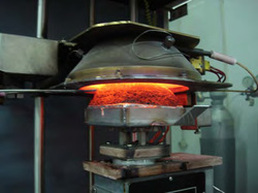Background Theory: The Process of Intumescence

Char Formation in Cone Calororimeter, Mesquita 2007
Passive fire protection coatings with intumescent properties have been in use since circa 1938 (Wilkie 2000). However, the process of intumescence is still far from being quantitatively understood.
There are four categories of chemical compounds in intumescent coatings:
Relatively little has been published on the actual chemical reactions and physical mechanisms which occur upon heating intumescent coatings. However, the fundamentals of the reactions are widely understood. Intumescent coatings are inert at low temperatures. When exposed to high heat flux, an inorganic acid, typically in salt form, is released. Catalysed by an organic amine (or amide), this acid dehydrates the carbon-rich polyhydric compound. The intumescent mixture then melts and, at a temperature corresponding to the proper viscosity, an endothermic reaction takes place. Thus generating gases which diffuse into small bubbles (of typical diameter 10-60 microns) resulting in the formation of a foam. The foam solidifies through cross-linking into a thick multi-cellular char which has a low thermal conductivity. (Butlet 2006)
Intumescent development depends upon the initial dry thickness, the incident heat flux (Mesquite 2007) and the polymerisation degree. The timing and sequence of the aforesaid chemical events is critical. In particular, the timing of the decomposition of the blowing agent with respect to the melt viscosity i.e. the concluding char forming process. If gasification takes place when the melt viscosity is too low (i.e. the molten mixture is not fluid enough), bubble growth will be strongly resisted and the gas will merely diffuse through the mixture without generating foam. If the melt viscosity is too high (i.e. the molten mixture is too fluid), the fluid resistance will be too low and the resulting bubbles formed will be too large thus producing a fragile and ineffective char (Butlet 2006).
There are four categories of chemical compounds in intumescent coatings:
- A carbonisation agent
- A carbon-rich polyhydric compound (a carbonific)
- An acid source
- A foaming agent (a spumific)
Relatively little has been published on the actual chemical reactions and physical mechanisms which occur upon heating intumescent coatings. However, the fundamentals of the reactions are widely understood. Intumescent coatings are inert at low temperatures. When exposed to high heat flux, an inorganic acid, typically in salt form, is released. Catalysed by an organic amine (or amide), this acid dehydrates the carbon-rich polyhydric compound. The intumescent mixture then melts and, at a temperature corresponding to the proper viscosity, an endothermic reaction takes place. Thus generating gases which diffuse into small bubbles (of typical diameter 10-60 microns) resulting in the formation of a foam. The foam solidifies through cross-linking into a thick multi-cellular char which has a low thermal conductivity. (Butlet 2006)
Intumescent development depends upon the initial dry thickness, the incident heat flux (Mesquite 2007) and the polymerisation degree. The timing and sequence of the aforesaid chemical events is critical. In particular, the timing of the decomposition of the blowing agent with respect to the melt viscosity i.e. the concluding char forming process. If gasification takes place when the melt viscosity is too low (i.e. the molten mixture is not fluid enough), bubble growth will be strongly resisted and the gas will merely diffuse through the mixture without generating foam. If the melt viscosity is too high (i.e. the molten mixture is too fluid), the fluid resistance will be too low and the resulting bubbles formed will be too large thus producing a fragile and ineffective char (Butlet 2006).

This website was created, by Connie Leydon and Patricia Lehane, in partial satisfaction of the requirements for the degree of Master of Engineering, in Civil Engineering (Leydon) / Civil & Environmental Engineering (Lehane), at the University of Edinburgh, U.K. ©
